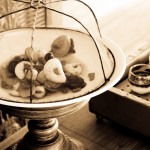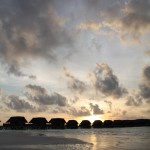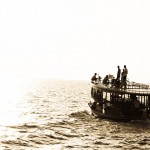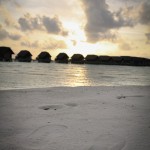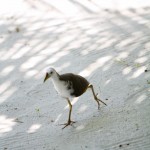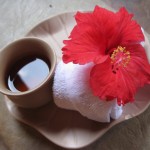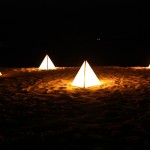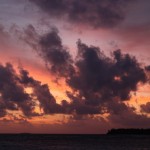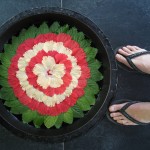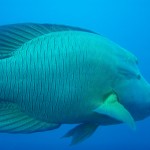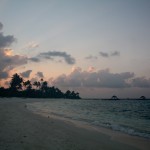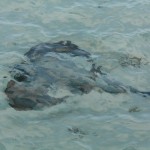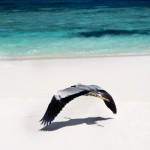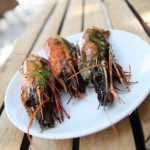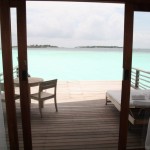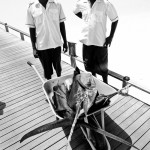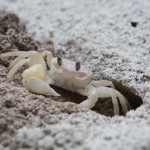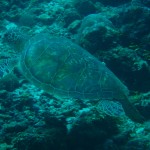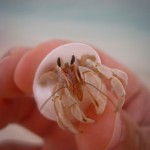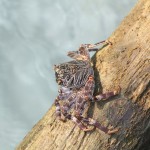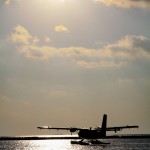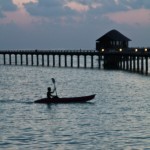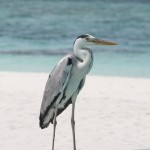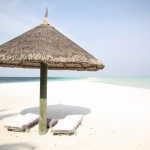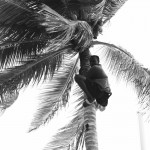Confetti: Maldives (Travel)
A young coconut is not brown, but rather green with smooth skin. It’s one of the things you learn on honeymoon in a tropical paradise like the Maldives. We Irish, of course, are familiar with the hairy dark exported coconut with its three black eyes that no-one eats at Halloween. But before the fruit of the coconut palm matures, it’s a much larger green pod, about the size of a rugby ball except not as pointy at the ends. Every morning Mani, our house servant at the Hilton Iru Fushi would scamper up the tree in the garden of our villa and hack one down for our breakfast, whittling off the top with a machete like he was cracking a boiled egg. Sipping the coconut water inside, while gazing out at the Indian Ocean, is as close as to paradise as anyone could hope to experience.
Close your eyes and imagine a tropical island: secluded white sandy beaches, palm trees swaying gently in a cool breeze and a crystal clear sea, filled with colourful fish. Luxurious hotel rooms with crisp, linen sheets, ocean views and invisible service. This is the promise of the Republic of Maldives: 1200 tiny islands that stretch like a string of pearls for 730km across the largest known reef formation in the world, 250 miles southwest of the tail of India. We would stay first at the Iru Fushi Hilton and then on to Cocoa Island.
IRU FUSHI
The seaplane from Malé to Iru Fushi is neither cheap (€320pp) nor comfortable, but it gives you a stunning bird’s eye view of the atolls (islands) as you soar above. Most are uninhabited, no more than white sand-dunes sticking out of the sea, a poignant reminder that the Maldives islands are on borrowed time. After a brisk but bumpy 45 minutes we arrive at the 180 villa Hilton resort of Iru Fushi which, despite having just a 20 minute walking circumference, is one of the largest atolls in the republic. There are two types of standard accommodation: beach villas and water villas and both are typical of the Maldivian hotels in general. Water villas (€360 per night) are commonly styled on Dhonis, the fishing boats typical to the region. We stayed at a beach villa and the rooms are exquisite: king sized poster bed; marble and dark wood interiors with back and front outdoor lounging areas containing a Jacuzzi, outdoor and indoor showers and our own coconut palm.
So what do you do with seven days on a tropical island? The answer is, not very much. There are a few activities provided, but unsurprisingly few people sign up for volleyball or 5-a-side soccer on honeymoon. Diving and snorkelling are, of course, the main attractions. The Republic of Maldives is 99% underwater and as a result an extremely bio-diverse region in terms of marine life: a trip out on a dive-boat to snorkel or scuba is an absolute must. On our trip to Shark Point we saw around 20 sharks, a few turtles, a napoleon fish, lionfish and moray eels as well as two giant manta ray, the most majestic fish in the sea. I have been fortunate to dive in a number of places and this was the best dive I’ve had ever had.
If you’d rather stay dry, all of the hotels in the Maldives offer the chance to go on sunset and sunrise fishing trips by boat at varying costs. The chances of catching something are considerable and the upshot is that you can eat what you land the next day for a small fee. Barbequed red snapper, fresh from the ocean, was one of the food highlights of the entire trip.
The rest of the time is spent between five restaurants, the cocktail bar and the beach, which is surprisingly unpopulated. Even though we visited the hotel at 92% occupancy, we saw no more than four people from our sun-loungers for the entire duration. This is what the Maldives is all about: seclusion, romance, a taste of paradise. Our most treasured memory of Iru Fushi was provided by the Indian Ocean. At night the shoreline is lit up with a swathe of beautiful twinkling fairy lights – the result of an algal bloom of bioluminescent plankton. These tiny blue stars glow in the water to guide you on a midnight stroll down the beach – an unforgettable sight. After seven nights of bliss at Iru Fushi we flew back down to Male and took a speedboat to our final destination, Cocoa Island.
COCOA ISLAND
An exclusive resort with a price tag to match, Cocoa Island is a special kind of perfection. Named by Sunday Times Travel Readers as favourite resort hotel in 2011, the island is just 600 paces long is like a project spawned from the minds of Robinson Crusoe and Christian Dior. Cocoa was a deserted island until 1980 when a photographer named Eric Klemm stopped by on an assignment. He fell in love with the place and inquired about leasing the island for his home but the laws at the time dictated he could only lease if he had a hotel on the island. Despite having absolutely no experience in the area, he recruited a team of islanders and together with some local businessmen, went about hacking down the vegetation to create a basic B&B serving the most adventurous of the elite in simple luxury. 30 years later, the island is completely transformed into an exclusive 30 villa tropical oasis, yet the original style and laid-back ethos remains.
The architecture of Cocoa is truly stunning- the island looks like the location for the perfect Vogue editorial. Giant wooden swings and silk French chaise longues populate the island like works of art. The rooms provide a luxury reserved for the super-rich. We stayed at a loft villa, which was nothing short of breathtaking. From the high ceiling, a large wooden fan slowly spins above a spacious living room, where the entire back wall is giant glass window onto the stretching aquamarine below. Here, friendly crabs, ray and baby black-tipped sharks, swim only feet away from the steps of your balcony.
In fact, it’s the natural environment that makes the Maldives so special. You can find white sandy beaches anywhere, but the Maldives are alive: Geckos and lizards on the ground, bats in the trees, herons and water hens in the air, turtles and hermit crabs on the beach and lionfish and coral in the sea. There are few destinations left in the world so populated with so many wild and beautiful species.
The breakfasts at Ufaa, the only restaurant on the island, are a gastronomic experience. There are no substitutes or compromises on quality here, with fresh tropical fruit on home-made yoghurt, freshly baked banana bread, waffles, bacon pancakes, and coffee to die for. Dinner in the evening is a semi-sophisticated affair that has an undeniable colonial feel. When the sun has disappeared, the island is drowned in darkness and the local staff, clad in white linen uniforms, take your order in perfect English but with a soft Indian accent. You could be dining with the Maharajah at the turn of the 20th century. As for the food, you are set up for a nightly culinary delight. Some might see the particularly creative menus as a negative. Almost every dish is a paragraph long on the menu and the food could probably benefit from a bit more simplicity: the sauces were very rich and the combinations of flavours, while creative, didn’t always work.
Other than eating and world-class diving, the main activity that Cocoa provides is pampering. Sessions in the award-winning Como Shambala Spa range from around €80 to €150 for an hour and cover pretty much everything you can think of: massages, wraps, body scrubs, facials and pedicures, you could spend a fortune and an age in the Spa and not have the same treatment twice. That’s either a really good thing or a bad thing: I‘m not sure which.
Depending on your outlook, the possible drawback of the serenity of Cocoa Island is that, aside from some excellent diving (though suited more toward intermediate divers), there is very little to do. Cocoa island is a retreat designed with one thing in mind: Relaxing. The problem with that is that weather in the Maldives can be unpredictable and spending around €1,000 a night to stay in a beautiful room while it rains outside can be a depressing experience. For this reason, you should really only book from the end of October onwards if you want to be reasonably sure of sunny weather. The rainy season is from May to October and, while there are some bargains to be had if you book during this period, you’ll be taking a sizeable risk.
Sadly, a trip to the Republic of Maldives is a once in a lifetime experience in more than one sense: rising sea levels threaten the entire region. By 2100, it’s estimated that the islands as we know them, will be gone. The country needs as much tourism now as it can get because the entire population, most of which lives in poverty, will have to repatriated to nearby countries. So buy a dress in Oxfam, cancel the wedding singer and cut your guest list in half, whatever you have to do to make your dream holiday come true. Paradise needs you.
